|
In addition to teaching Western Music courses including
Music 101: Introduction to Music, Music 105/6: Fundamentals of Music, Musiciaship Sequence 201, 301 and 302: Music Theory Section
of Musicianship, when I joined Wabash College I introduced to the
College curriculum several ethnomusicology-related courses that
I teach. They are:
MUS 102 WORLD MUSIC
This course offers the participants an introduction to
the various world musical cultures and practices found outside the
Western Classical Art tradition. The course gives an overview of
music genres, instrumental types and resources, forms, and styles
that originate from selected world music traditions in sub-Saharan
Africa, Arabic Africa, Middle East, Near East, North America, South/Latin
America, and the Caribbean region. Musical practices are studied
in terms of structure, performance, aesthetic values, cross-cultural
contacts, contextual function, and significance. Coursework includes
weekly reading and listening assignments, musical demonstrations,
and hands-on experience, as well as the acquisition and development
of listening skills. It is open to all students. This course is
offered in the fall semester.
MUS 202: INSTRUMENTS AND CULTURE.
This course is an introduction to world-music instrumental
cultures with an emphasis on organology. A wide selection of traditional
instruments will provide a basis for the study of cultural, scientific,
and artistic aspects of instrumental music. Specific cultures are
illuminated by the examination of aesthetic principles valued by
each tradition, the role of musical instruments in culture, the
theory of each tradition, and the visual representation of the instrument
as both a sound and an art object. The course culminates in a final
course project. For this project, students may choose to write a
term paper, give a class paper presentation, perform on a traditional
instrument, or design and build an instrument. To build an instrument,
the students have the option of constructing either a) a replica
of an existing instrument, or (b) modified traditional instrument,
or (c) creating a totally new musical instrument design. This course
is offered in the spring semester.
The 2006 spring semester Music 202 class below, designed
and constructed 4 chordophones, 2 idiophones, 2 aerophones, and
1 membranophone.
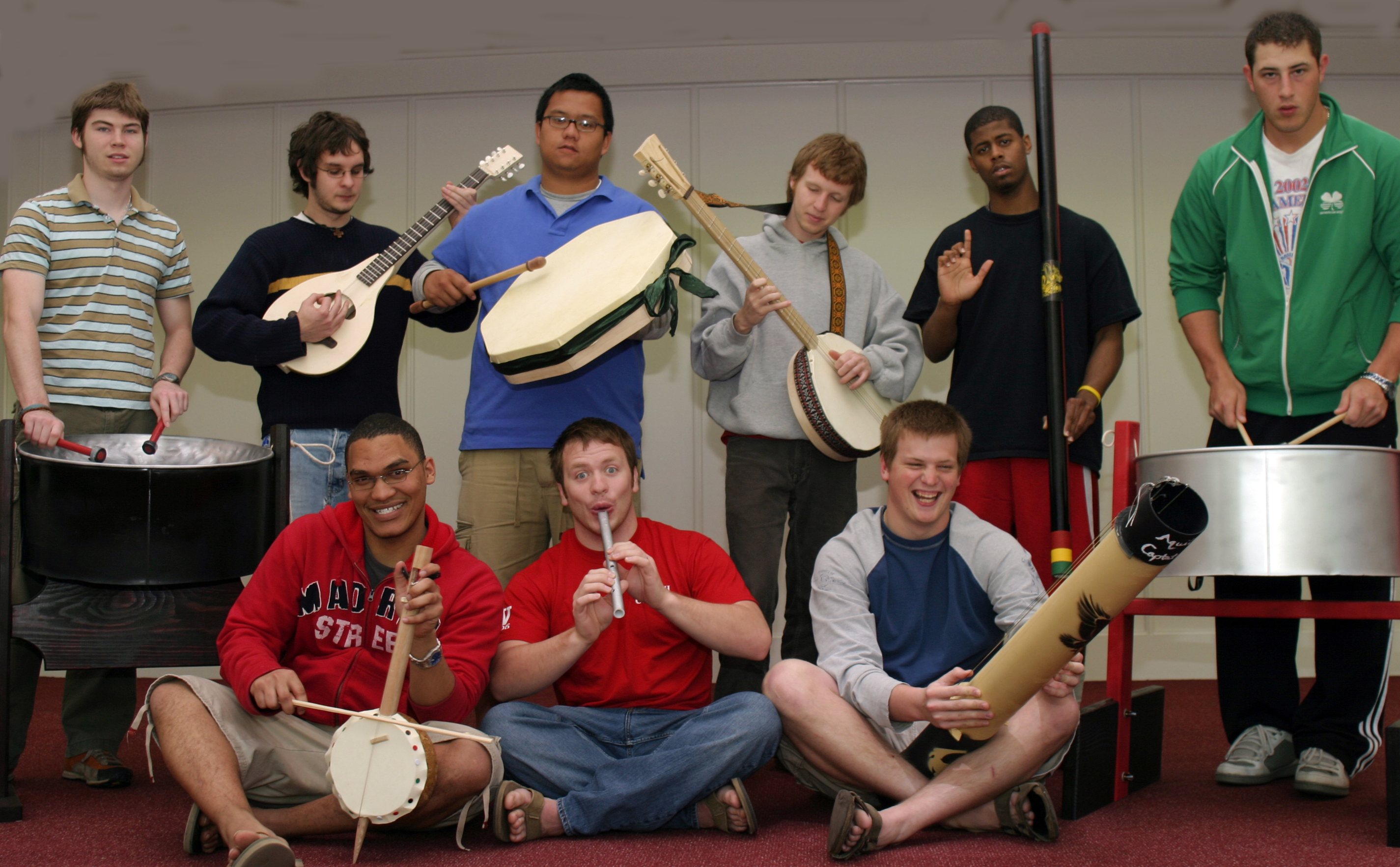
One Membranophone:
Bodhrán (an Irish drum) by Ben Abratigue '06
Two Idiophones:
Steel Drum (a Trinidad/Tobago drum) by Jay Brouwer '09
Steel Pan (a Trinidad/Tobago drum) by Travis Moore '06
Two Aerophones:
Didgeridoo (an Aboriginal horn) by Marcus Cooke '09
Printer's Pipe (an American reed fife/flute) by Tim Barnes '06
Four Chordophones:
Bouzouki (a Turkish lute) by Andrew Brimm '09)
Classical Sitjo (a sitar-banjo) combination by
Curtis Eilers '06
Kemancheh (a Turkish spike fiddle) by Bernard Meyer '07)
Valiha (a Madagascan tubular zither) by Kyle Greaves '09
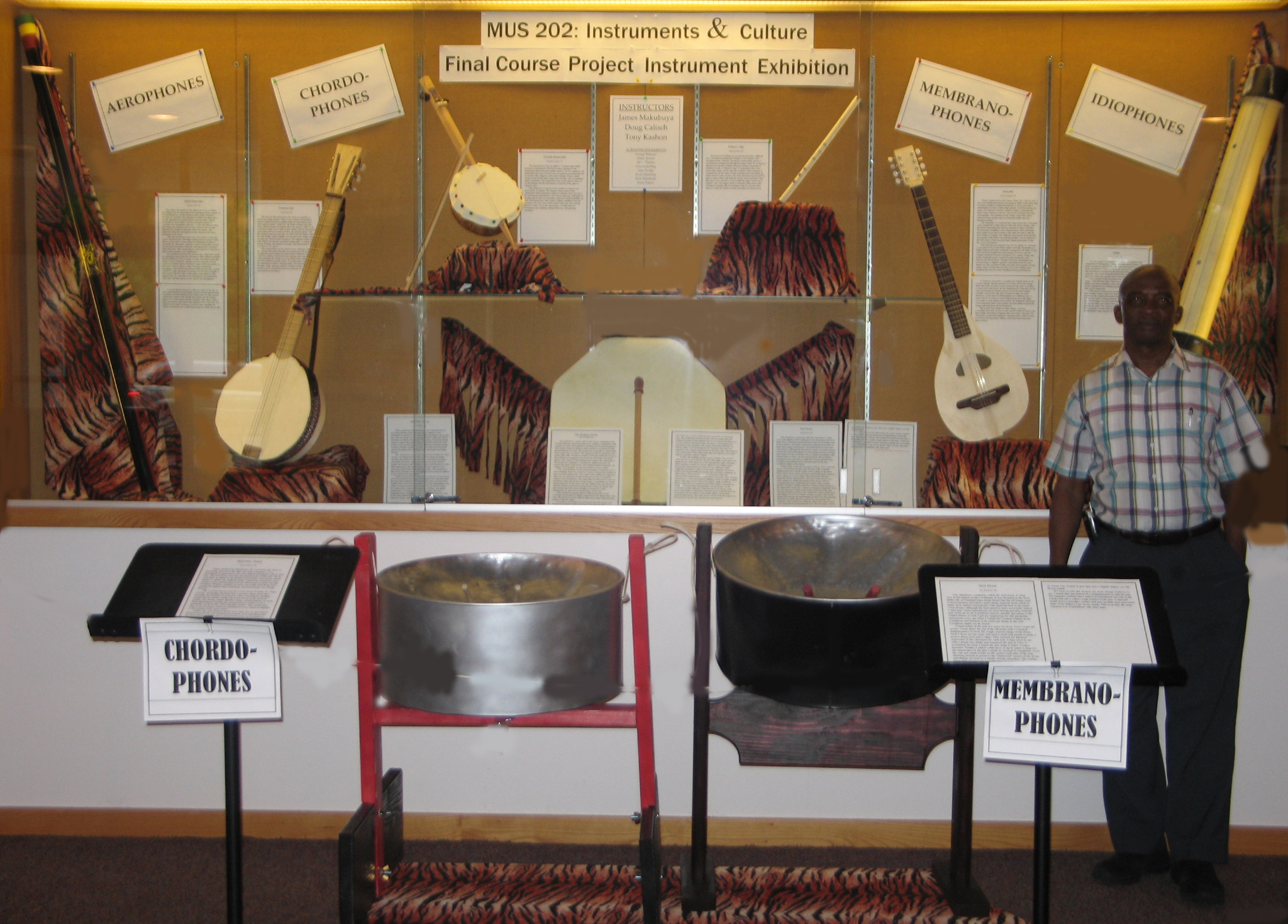
Spring 2006 Final Course
Projects Display
and the
Music 202 Course Instructor, Dr. James Makubuya
MUS 224: GLOBAL PERSPECTIVES ON MUSIC CULTURES AND IDENTITY
This Course is designed to develop the students’ awareness and analytical appreciation of global music diversity found within a variety of world music cultures. The course will seek to develop students’ awareness of the existence of global music cultures and the ways in which those music cultures differ. In addition, it will also encourage self-reflection of students’ own cultural music perspectives. Furthermore, the course will develop an awareness of the extent to which the various music cultures could also serve as resources for the understanding of the identities of the people that use the covered music systems (as case studies).
MUS 287: INDEPENDENT STUDY
This course offers students an opportunity to pursue advanced
study in organology with special focus on the folk musical instruments
of East Africa. Permission for the independent work and study must
be granted before registering. Previous topics have included “Endongo
(8-string bowl lyre) Advanced Performance Skills;” “
Amadinda (12-slab log xylophone) of the Baganda: Its Origin
and Evolutionary Development;” “Advanced Plucking Technique
of the Adungu (9-string bow harp of the Alur),” and
"The Building of the Cone-shaped Ngoma (drums) of
the Baganda."One-half or one course credit; This course is
offered in the fall and spring semesters.
MUS 313: SEMINAR IN MUSIC HISTORY
This is an advanced topics course, which changes from year
to year. Previous topics have included American Music, Choral Literature,
Major Figures of Jazz and Selected Topics in Ethnomusicology (or
World Music). This course may be repeated for credit when a different
topic is offered. To take the advanced seminar in ethnomusicology,
a student needs permission of the instructor.
FRT-00P-001: FRESHMAN TUTORIAL
During the spring semester, the freshmen who take this
course attempt to examine the Global contextual meaning and significance
of music in folk {or traditional} societies. A random sampling of
the folk societies’ definition of music appears to extend
way beyond the basic dictionary definition of the ‘vocal and/or
instrumental sounds as well as notation.’ By examining folk
society events from a variety of cultures, this tutorial searches
for and examines the defining characteristics of this global form
of expression in the context of folk societies. The tutorial further
explores the similarities and differences between the ways different
societies use music as an essential ingredient of their life styles.
The focus of the course is on the weekly listening and reading assignments
as well as videos given in class and the syllabus. The results of
the class work is intended to pave way for meaningful oral class
presentations, as well as written analytic and research papers.
The classes examine musical practices in terms of structure, performance,
aesthetic values, contextual meaning, function and significance.
Coursework includes in-class instruction, oral discussion, analysis
of cultural/societal events (rituals, rites, and ceremonies) enhanced
by/with musical performances. With the use of video and audio illustrations,
the class examines the how’s and why’s in the way different
cultures perform and use music in the various context/s and/for
multipurpose ends.
MUS 056: WAMIDAN WORLD MUSIC ENSEMBLE
WAMIDAN is the Wabash College World Music Performance ensemble.
Although it was originally founded “for those interested in
exploring the artistic and scientific myths and mysteries of Sub-Saharan
African music” James Makubuya, Founder, September 20, 2000,
the ensemble has since expanded to offer a forum for members to
extend their talents to music and dances of cultures from different
parts of the globe as well. The unique musical instruments introduced
so far to the Wamidan active participating members include East
African lyres, harps, thumb pianos, tube fiddles, log xylophones,
panpipes, conical and cylindrical drums – and most recently
Australian Aboriginal didgeridoos. The ensemble is open to students,
members of staff and faculty as well as the community of the city
of Crawfordsville. No previous experience is required to join this
ensemble.
Instrumental Music
Wamidan instrumental music is taught with two different but related
objectives and formats in mind. One is that of training players
to learn the skills necessary to and perform items in large ensembles
and play as a large group. The second one offers an opportunity
to members who are interested in even more advanced skills that
would eventually enable them to perform chamber-like music ensembles
of quartets, trios, duets or solos.

Adungu (bow harp)
Ensemble in Concert
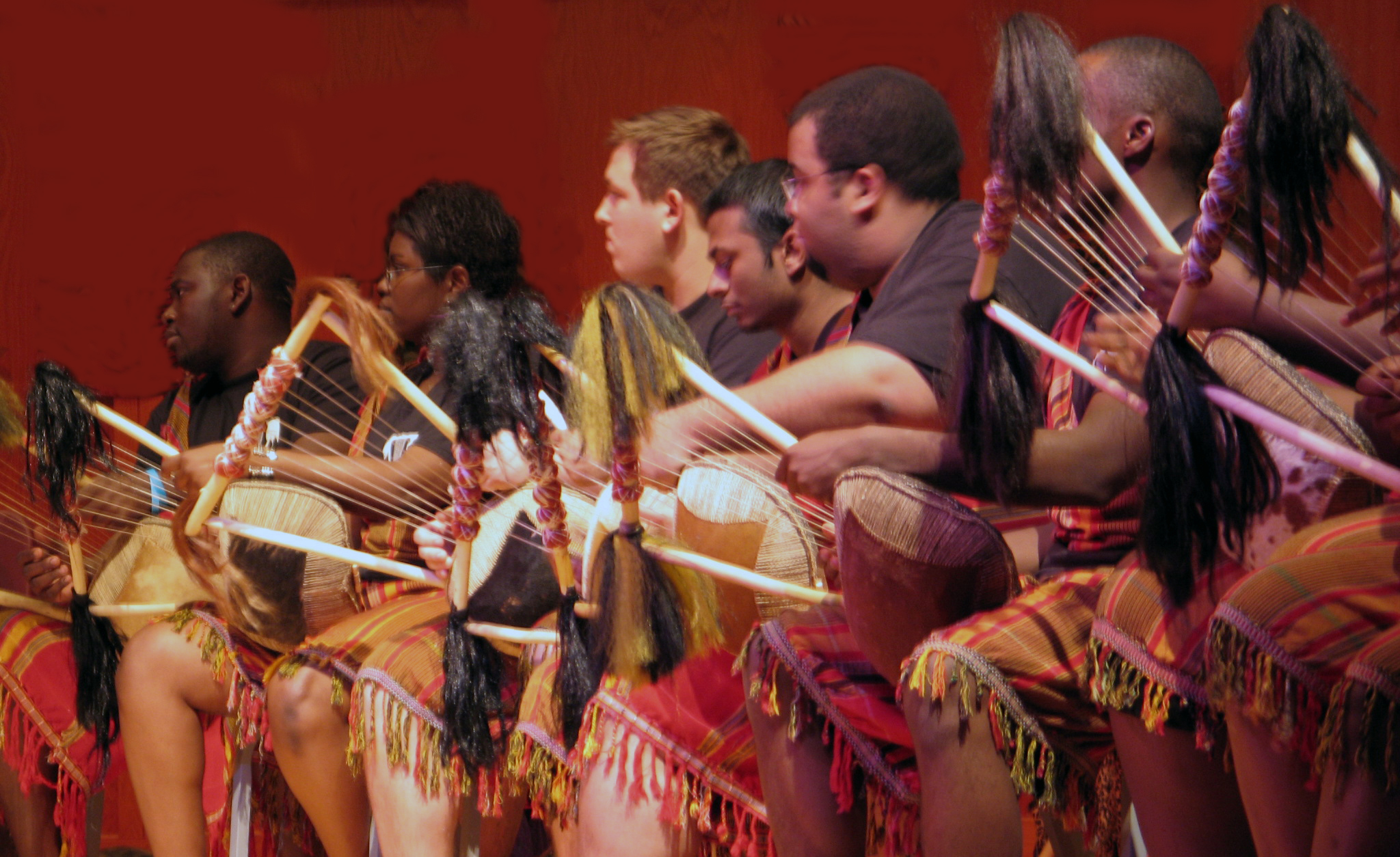
Endongo (bowl
lyre) Ensemble in Concert
Folk/Traditional Dancing
Because of the common inter-relatedness (in folk performances) between
instrumental music, singing and dance, Wamidan repertoires encourage
practice and active participation that lead to the masterly of performance
skills in both instrumental music, singing, and dancing.
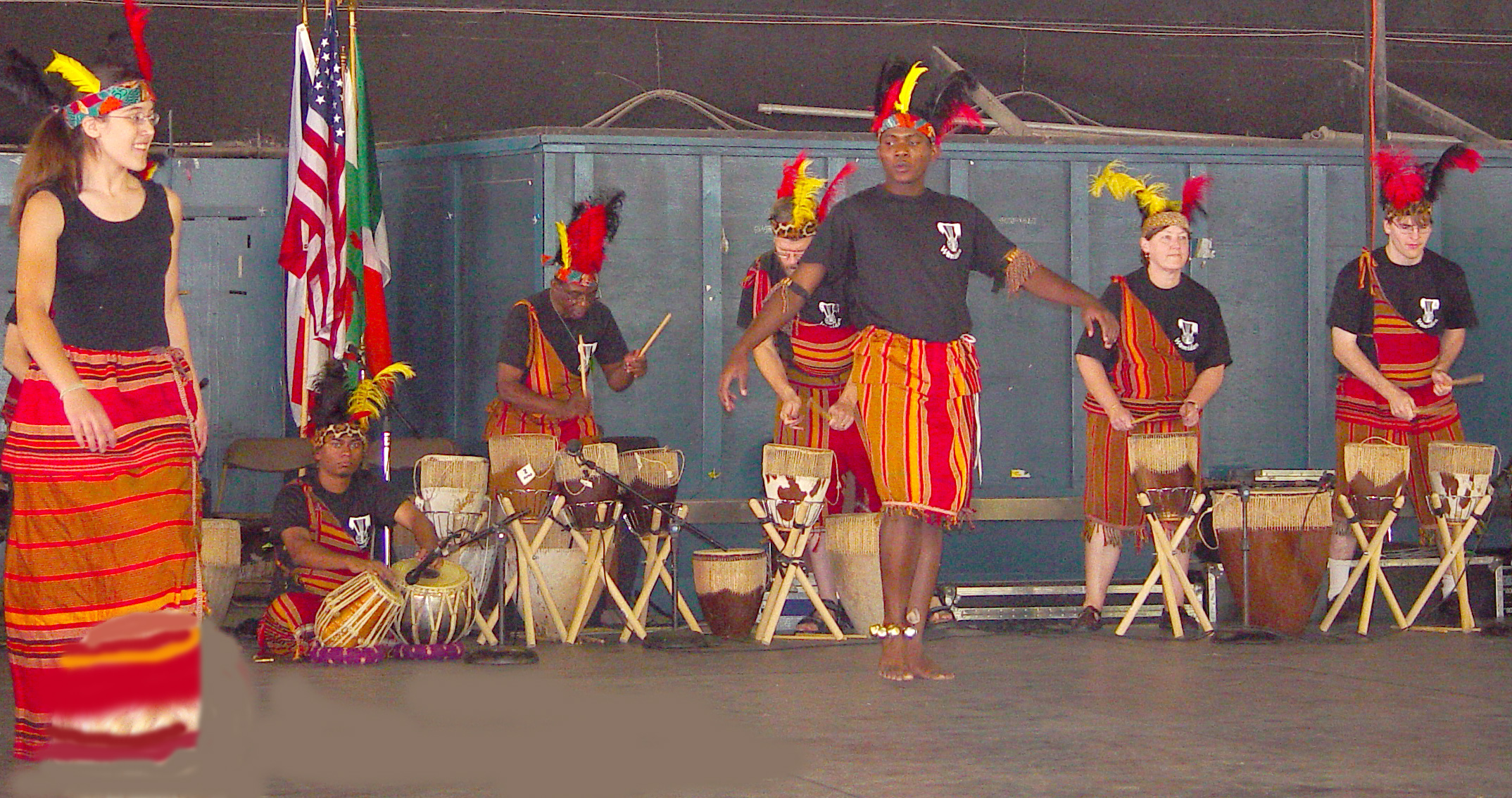
Wamidan Dancers Performing Aije
at the Cincinnati Folk Festival
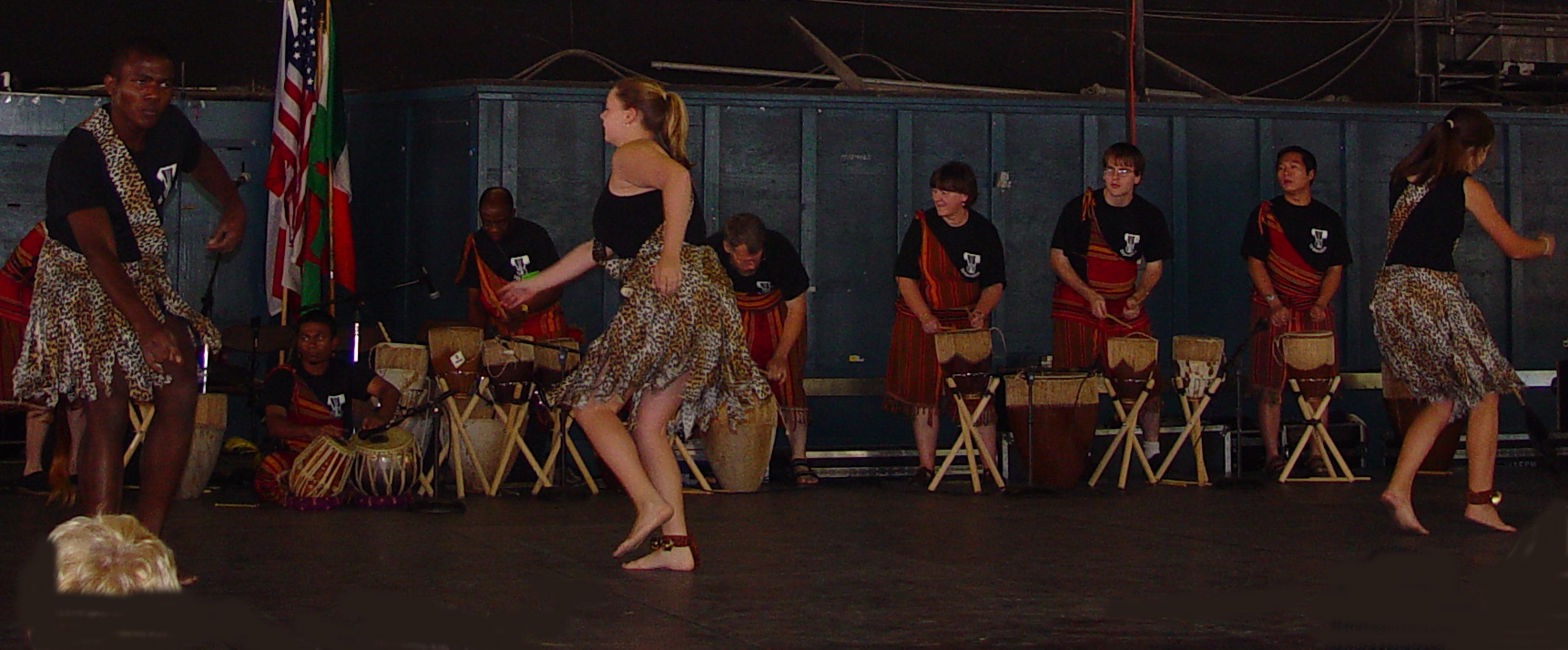
Wamidan Dancers Performing Olukhun
in Concert |






